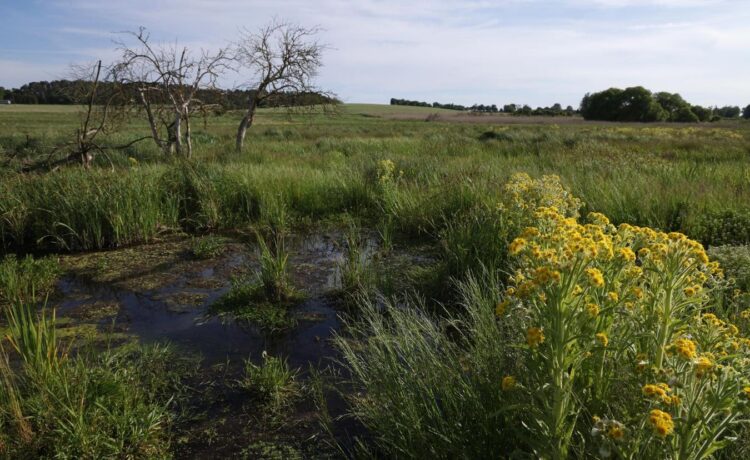GREIFFENBERG, GERMANY – MAY 31: Plants, including a flowering swamp ragwort (Tephroseris palustris … [+]
Wetlands are superheroes in tackling climate change. Peatland, a key category of wetlands, covers only about 3% of the world’s total surface area but holds 30% of all natural carbon, almost twice that in forests. Today is World Wetlands Day, a day to raise global awareness about the importance of these ecosystems for our planet.
The Wetlands Day was first celebrated in 1971 and marks the anniversary of the Convention of Wetlands, an international treaty of the United Nations. Protecting Wetlands for Our Common Future is the theme for World Wetlands Day 2025. Wetlands, as the name suggests, are wet areas of land. They can take multiple forms. Wetland International mentions 19 categories of wetlands in a report, ranging from coral reed—a coastal Wetland—to peatland—an inland wetland—to urban park pond—a human-made wetland.
Wetlands are among our most threatened ecosystems, disappearing three times faster than forests. Without restoration, they can become sources of carbon dioxide instead of carbon sinks and release significant amounts of carbon emissions back into the atmosphere. Thus, there is a strong case for restoring and investing in them. As the world celebrates this day, let’s consider two things that need to be done to increase investment in this special ecosystem.
1. National Targets For Restoration Of Wetlands
There is scope for improvement in how wetlands are represented in the National Biodiversity Strategies and Action Plans. Although 24 of the 25 NBSAPs mention wetlands. based on the reports submitted up to October 2024, they have not comprehensively integrated wetlands throughout the different targets, based on an assessment done by Wetland International.
Only about half of the countries currently have any measurable targets in terms of area, km of river length or percentages. Even if countries use the term wetlands, they frequently only refer to one or a select few wetland categories, not paying enough attention to other types. Most frequently, they refer to mangroves, rivers, lakes, coral reefs, marshes/ponds and peatlands,
Government wetland restoration targets are essential to showcase government commitment and can raise the significance of investment in this sector. The Scottish Government aims to restore 250,000 hectares of peatland by 2030. Although 250,000 represents only about 20% of its peatlands, the symbolic announcement can attract funding from other players.
2. Clear Entry Points For Private Investment In Wetlands
Private sector investment in the wetlands is abysmally low. Foundations and governments are the primary sources of capital in the space so far. The private sector has not stepped up to the extent needed because of a lack of financial mechanisms and clear investable pipelines.
Carbon funds are an attractive financial mechanism that allows private players to enter. Scotland has proposed a Carbon Fund as an investment vehicle where private investors can invest in high-integrity peatland restoration projects in exchange for financial returns generated from the sale of carbon credits. Carbon fund was one of the two methods proposed by the Scottish Government in a white paper to attract private investment in natural capital. The other was a Price Floor Guarantee, which builds confidence by reducing the downside risk profile for investors and project developers.
Carbon reduction is not the only benefit that comes from wetlands. Many scientists are calling for moving from a carbon-centric approach to a payment-for-ecosystem approach. Last year, a group of scientists from a few universities in Germany published a paper encouraging the use of a methodology that enables the quantification of ecosystem services from peatland rewetting. Their method assessed ecosystem services under the MooreFutures standards, an early standard for generating credits from peatland rewetting. The scientists compared rewetting land before and after to find benefits for carbon reduction, water quality, evaporative cooling, and biodiversity.
Another mechanism to attract the private sector is landscape initiatives, which can bundle multiple projects into investment-ready portfolios, a key recommendation from a Investing in Peatlands report published under a European Union research consortium. Legal entities and special-purpose vehicles could be created to interface with investors and deploy capital. Investment-ready portfolios can offer a range of payback mechanisms, including carbon credits, ecosystem services, and new commodities such as biomass.
With the launch of the Taskforce of Nature-Related Financial Disclosures and a growing emphasis among investors and companies on quantifying nature-related impacts of their value chain, one can be optimistic that wetlands, can receive more attention.
As we celebrate World Wetlands Day, let’s once again recognize these superheroes, not only for their role in carbon reduction but also for their ability to support the entire ecosystem, water quality, and biodiversity. Meaningful government targets and innovative and implementable financial mechanisms are the key to unlocking investments in this vital landscape.





